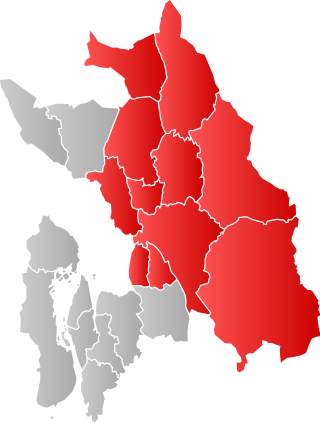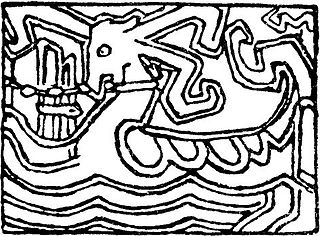
Harald Fairhair was a Norwegian king. According to traditions current in Norway and Iceland in the eleventh and twelfth centuries, he reigned from c. 872 to 930 and was the first King of Norway. Supposedly, two of his sons, Eric Bloodaxe and Haakon the Good, succeeded Harald to become kings after his death.
Harald Greycloak was a king of Norway from the Fairhair dynasty.

The Battle of Svolder was a large naval battle during the Viking age, fought in September 999 or 1000 in the western Baltic Sea between King Olaf of Norway and an alliance of the Kings of Denmark and Sweden and Olaf's enemies in Norway. The backdrop of the battle was the unification of Norway into a single independent state after longstanding Danish efforts to control the country, combined with the spread of Christianity in Scandinavia.

Hafrsfjord or Hafrsfjorden is a fjord in the Stavanger Peninsula in Rogaland county, Norway. The 9-kilometre (5.6 mi) long fjord forms the border between the municipalities of Stavanger and Sola. On the west side of the fjord is the large village of Tananger, on the south is the village of Solakrossen, and on the east end of the fjord is the borough of Madla in the city of Stavanger. The Møllebukta bay area, located on the innermost part of the fjord, is the site of a popular beach and the Sverd i Fjell statues. The only bridge over the fjord is the Hafrsfjord Bridge which runs between Kvernevik in Stavanger and Jåsund in the village of Tananger in Sola.
Kjotve the Rich was a king of Agder, then one of the petty kingdoms of Norway during the late 9th century. Kjotve led the western Norwegian kings against King Harald Fairhair at the Battle of Hafrsfjord. Defeated by Harald, Kjotve fled; many of his allies were killed in the battle. His son Thorir Haklang was a berserker who fell during the Battle of Hafrsfjord.

Romerike is a traditional district located north-east of Oslo, in what is today south-eastern Norway. It consists of the Viken municipalities Lillestrøm, Lørenskog, Nittedal, Rælingen and Aurskog-Høland in the southern end, and Ullensaker, Gjerdrum, Nannestad, Nes, Eidsvoll and Hurdal in the northern end .
Håkon Grjotgardsson was the first Earl of Lade and an ally of Harald Fairhair, King of Norway.
Olaf Haraldssøn Geirstadalf Digerbein, was a reputed son of King Harald Fairhair of Norway with Svanhild Øysteinsdatter, daughter of Øystein Jarl.
Dag Ringsson was a Norwegian chieftain from Oppland who participated in the Battle of Stiklestad during 1030 which resulted in the death of King Olaf II of Norway

The petty kingdoms of Norway were the entities from which the later Kingdom of Norway was founded. Before the unification of Norway in 872 and during the period of fragmentation after King Harald Fairhair's death, Norway was divided in several small kingdoms. Some could have been as small as a cluster of villages, and others comprised several of today's counties.

Glymdrápa is a skaldic poem composed by Þorbjörn Hornklofi, the court poet of King Harald I of Norway. Composed toward the end of the 9th century, the poem recounts several battles waged by King Harald, mostly as he was uniting Norway.

Ytraberget is a small peninsula that sticks out into the Hafrsfjord in the municipality of Sola in Rogaland county, Norway. Ytraberget is connected to Indraberget and it is located, just north of the village of Sørnes, between two small bays: Sørnesvågen and Grannesvågen.

Tora Mosterstong —also known as Thora Mostaff—was one of Harald Fairhair's concubines and the mother of Håkon the Good; Harald Fairhair's youngest son and the third King of Norway.

Gyda Eiriksdottir of Hordaland was a semi-legendary Norwegian concubine during the Viking Era. She appears in the Saga of Harald Fairhair in Snorri Sturluson's Heimskringla. The story is not mentioned in any other source.

Haraldshaugen is a national monument in Haugesund, Norway. The monument was erected during the millennial celebration of Norway's unification into one kingdom under the rule of King Harald Fairhair .

The Earls of Møre were a dynasty of powerful noblemen in Norway dating to the unification of Norway in the 9th century. The first earl of Møre was Rognvald Eysteinsson, a close friend and ally of King Harald I of Norway. He is called by the byname Rognvald Mørejarl in the Heimskringla and Orkneyinga saga.

The Unification of Norway is the process by which Norway merged from several petty kingdoms into a single kingdom, predecessor to the modern Kingdom of Norway.

The Saga of Harald Fairhair is the third of the sagas in Snorri Sturluson's Heimskringla, after Ynglinga saga and the saga of Halfdan the Black. Snorri sagas were written in Iceland in the 1220s. This saga is about the Norwegian king Harald Fairhair.
The Thelir or Thilir was a North Germanic tribe that inhabited the region now known as Upper Telemark in modern Norway during the Migration Period and the Viking Age. The region of Telemark, which originally was only referred to Upper Telemark, was named after them, and means the "mark of the Thelir." The Thelir are mentioned in the Saga of Harald Fairhair by Snorri Sturluson, as one of the tribes who fought against Harald Fairhair in the Battle of Hafrsfjord.
Ragnhild the Mighty was a wife of Harald Fairhair, according to Icelandic historian Snorri Sturluson.














